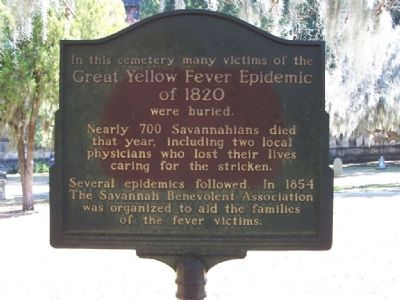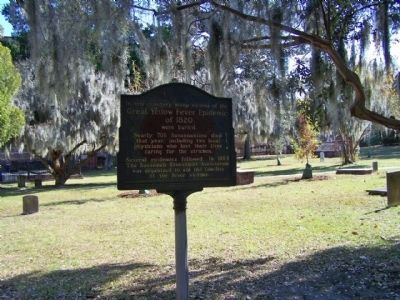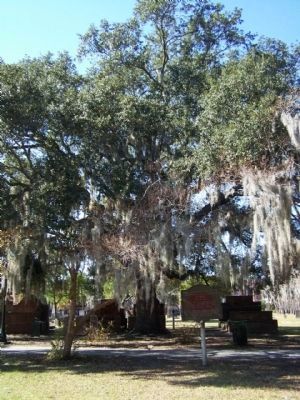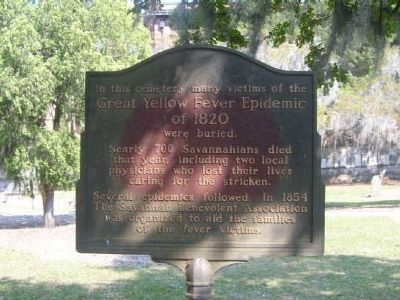Historic District - North in Savannah in Chatham County, Georgia — The American South (South Atlantic)
Great Yellow Fever Epidemic of 1820
Inscription.
Great Yellow Fever Epidemic
of 1820
were buried.
Nearly 700 Savannahians died
that year, including two local
physicians who lost their lives
caring for the stricken.
Several epidemics followed. In 1854
The Savannah Benevolent Association
was organized to aid the families
of the fever victims.
Erected 1970 by The Trustees Garden Club.
Topics. This historical marker is listed in these topic lists: Cemeteries & Burial Sites • Science & Medicine. A significant historical year for this entry is 1820.
Location. 32° 4.532′ N, 81° 5.371′ W. Marker is in Savannah, Georgia, in Chatham County. It is in the Historic District - North. Marker is on E. Oglethorpe Ave, on the right when traveling east. Located in the Colonial Park Cemetery, Savannah, Ga. Touch for map. Marker is in this post office area: Savannah GA 31401, United States of America. Touch for directions.
Other nearby markers. At least 8 other markers are within walking distance of this marker. Nathanael Greene, Maj. Gen., Continental Army (within shouting distance of this marker); Hugh McCall (1767-1823) (within shouting distance of this marker); James Habersham (within shouting distance of this marker); Joseph Habersham (1751-1815) (within shouting distance of this marker); Button Gwinnett (within shouting distance of this marker); Major John Berrien (within shouting distance of this marker); William Scarbrough (within shouting distance of this marker); Gen. Samuel Elbert (1740-1788) (within shouting distance of this marker). Touch for a list and map of all markers in Savannah.
Regarding Great Yellow Fever Epidemic of 1820. 1820 was also the year of the yellow fever epidemic in which over a tenth of Savannah's population perished. From her early days Savannah had suffered yellow fever epidemics, and 1820 was not the last year of this disease, which recurred in stages until the end of the century.
Related marker. Click here for another marker that is related to this marker. To better understand the relationship, study marker shown.
Also see . . . Death at Savannah; Two Vessels Quarantined. In the days before vaccinations and improved medical techniques, outbreaks of disease such as Yellow Fever were met with quarantines and travel restrictions. This article from the New York Times from 1876 testifies to the reaction. (Submitted on February 12, 2008, by Craig Swain of Leesburg, Virginia.)
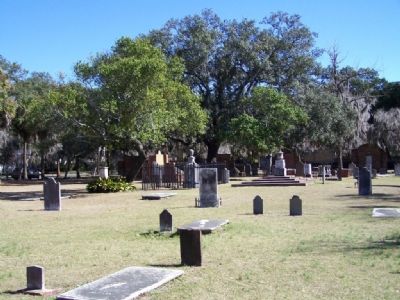
Photographed By Mike Stroud, February 1, 2008
5. A partial view of Colonial Park Cemetery
As General William T. Sherman pillaged and burned his way through Georgia during the Civil War, Union cavalry troops quartered in Savannah used the gated cemetery as a corral and grazing ground for their horses. Some of the cavalrymen dug for valuables among the graves. Local legend also says the mischievous Union troopers played a macabre joke on
their vanquished foes by switching around many of the headstones.
Credits. This page was last revised on February 8, 2023. It was originally submitted on February 12, 2008, by Mike Stroud of Bluffton, South Carolina. This page has been viewed 11,840 times since then and 85 times this year. Photos: 1. submitted on February 12, 2008, by Mike Stroud of Bluffton, South Carolina. 2, 3. submitted on November 24, 2008, by Mike Stroud of Bluffton, South Carolina. 4. submitted on October 6, 2012, by Brian Scott of Anderson, South Carolina. 5. submitted on February 12, 2008, by Mike Stroud of Bluffton, South Carolina. • Craig Swain was the editor who published this page.
